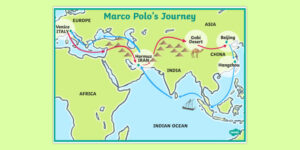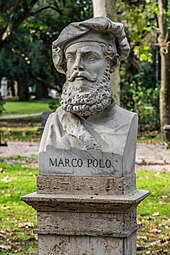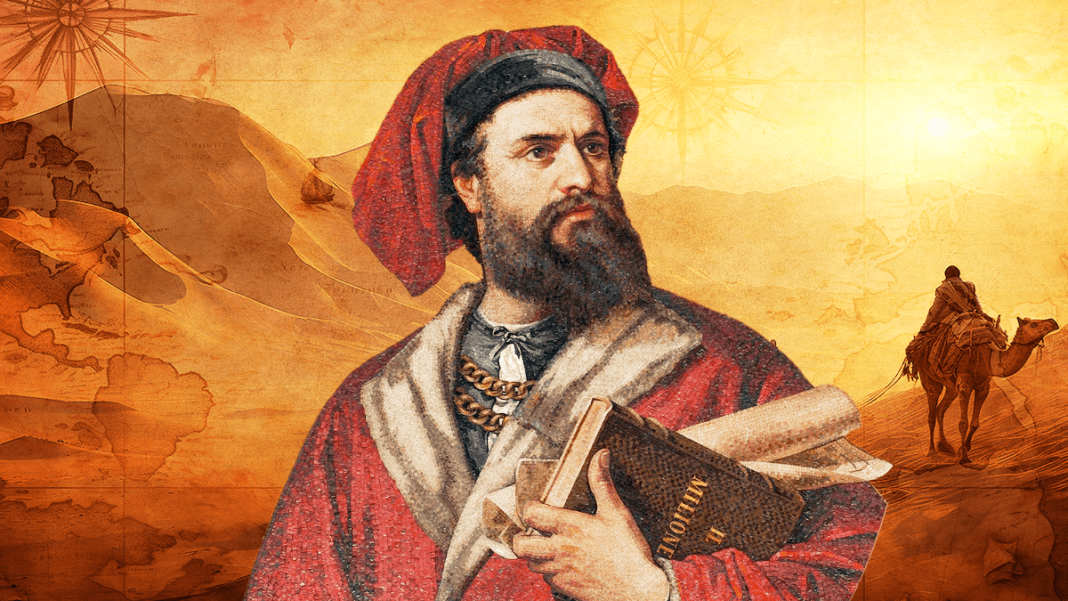Marco Polo:

Marco Polo was a Venetian merchant, a famous traveler, writer, and the author of the famous “Book of the Diversity of the World,” in which he told the story of his journey through the countries of Asia. Not all researchers agree with the veracity of the facts set out in the work, but to this day it remains one of the important sources on the history, ethnography, and geography of the Asian states of the Middle Ages. The book was used by sailors, cartographers, researchers, writers, travelers, and discoverers.
He traveled with Christopher Columbus during his famous voyage to America.
Childhood and youth:

Documents about Marco’s birth have not survived, so information about this period of his biography is inaccurate. It is believed that he was a nobleman, belonged to the Venetian nobility, and had a coat of arms. He was born on September 15, 1254, into the family of the Venetian merchant Niccolo Polo, who traded in jewelry and spices. He did not know his mother, as she died in childbirth. The boy was raised by his father and aunt.
The famous traveler’s birthplace could also be Poland and Croatia, which dispute this right, citing as evidence one or another fact confirming both versions. The Poles claim that the Polo surname is of Polish origin, while Croatian researchers are confident that the first evidence of the famous explorer’s life is on their land.
Travels and discoveries:

The father of the future traveler, due to his profession, traveled a lot. During his trips around the world, he discovered new trade routes. It was Niccolo who instilled in Marco a love of travel, telling about his adventures. In 1271, the young man set off on a journey with his father. Its final destination was Jerusalem.
In the same year, a new pope was elected, who appointed the merchant family (Niccolò, his brother and Marco) as official envoys to China, where at that time the country was ruled by the Mongolian Khan Kublai. The first stop on the Mediterranean coast was the port of Layas, a place where goods were brought from Asia, where they were bought by merchants from Venice and Genoa. Then their route passed through Asia Minor, Armenia, Mesopotamia, where they visited Mosul and Baghdad.
Then the travelers went to Persian Tabriz, where at that time there was a rich pearl market. In Persia, some of their companions were killed by robbers who attacked the caravan. The Polo family miraculously survived. Tormented by thirst in the hot desert, on the verge of life and death, they reached the Afghan city of Balkh and found salvation there.
The eastern lands where they found themselves, continuing their journey, were abundant in fruits and game. In Badakhshan, the next region, slaves mined precious stones. According to one version, in these places, due to Marco’s illness, the travelers stopped for a year. Then, overcoming the Pamir forts, they went to Kashmir. The traveler was surprised by the local sorcerers who influenced the weather, as well as the beauty of the local women.
After this, the Italians were the first Europeans to find themselves in the Southern Tien Shan. Then the caravan headed northeast through the oases of the Taklamakan Desert. The first Chinese city on their way was Shangzhou, followed by Guangzhou and Lanzhou. The merchant was greatly impressed by the local rites and customs, flora and fauna of this country. It was a wonderful time for his amazing travels and discoveries.

The family of Venetian merchants lived with Khan Kublai for about 17 years. The young man pleased the khan with his independence, fearlessness and good memory. He became close to the Chinese ruler, participated in state life, making important decisions, helped recruit an army, suggested using military catapults and much more.
Carrying out the most difficult diplomatic missions, Marco Polo visited many Chinese cities, learned the language and never ceased to be amazed by the achievements and discoveries of this people. He described all this in his book.
Khubilai did not want to let his assistant and favorite go, but in 1291 he sent him to accompany the Mongolian princess, who had married the ruler of Persia. The route passed through Ceylon and Sumatra. In 1294, while still on the campaign, news arrived that Khan Kublai had died.
Polo decided to return home. The route across the Indian Ocean was very dangerous, only a few managed to overcome it. The traveler returned to his homeland in the winter of 1295.
On native soil:

Two years after his return, the war between Genoa and Venice began, in which Marco Polo also participated. In 1298, during the Battle of Curzola, he was captured by the enemy and remained in prison until May 1299. Here, based on his travel stories, the famous book was written.
The traveler’s cellmate Rustichello (Rusticiano) also contributed to the work. There is a version that the text was dictated in the Venetian dialect, another says that the writing was done in Old French with notes in Italian. Since the original manuscript has not survived, it is impossible to verify the veracity of the theories.
Personal life:

The explorer’s father remarried and had three more brothers. After his captivity, Marco Polo’s personal life also went well: he married a noble and wealthy Venetian woman, Donata Badoer, bought a house and raised three daughters. The townspeople considered him an eccentric liar, not trusting his stories about distant travels. Marco lived a prosperous life, but yearned for travel, especially to China.
The only joy he found in Venetian carnivals, as they resembled magnificent Chinese palaces and luxurious khan outfits. After returning from Asia, the traveler lived for almost three decades. In his homeland, he was engaged in trade. “The Book on the Diversity of the World”, written in prison, made him famous during his lifetime.
In his last years, stinginess awakened in Marco Polo, which led him to legal proceedings with his own family. The traveler freed one of his slaves and bequeathed him part of his inheritance.
Death:

Polo died in 1324 in Venice at the age of 70. The exact cause of the traveler’s death is unknown, but some sources claimed that he had been battling an unknown disease for a long time.
He was buried in the Church of San Lorenzo. Marco Polo’s luxurious house burned down in a fire at the end of the 14th century. According to rumors, valuables brought from China were kept there. The church where the traveler was buried was destroyed in the 19th century.
Memory:

- In 1888, the butterfly Marco Polo jaundice was named after the great traveler.
- The international airport in Venice, founded in 1960, is named after the explorer. The Russian folk group, whose leader and vocalist is Lyudmila Savostyanova, also bears his name.
- There are many exciting films and TV series about Polo, his life and travels, which arouse genuine interest among our contemporaries.
- In 2007, Kevin Connor directed the TV project “Marco Polo” with Ian Somerhalder in the lead role. The cast also included BD Wong, Desiree Ann Siahan and Brian Dennehy. The work did not impress critics and viewers, as evidenced by mixed and critical reviews.
- After some time, Netflix decided on a big-budget series about the famous traveler, whose image went to the actor Lorenzo Richelmy. The creators released two seasons with 10 episodes each. The show had high ratings and positive reviews. It is noteworthy that filming took place in Italy, Malaysia and Kazakhstan.
- After the end of the first season, a short film and part-time special edition of the TV show “Marco Polo: Hundred Eyes” was released on the streaming service. The production was directed by American director of Uzbek origin Alik Sakharov.
Interesting facts:

- In one of the chapters of Polo’s work it is indicated that during his travels he made notes in a notebook, tried to be attentive to what was happening and record everything new and unusual that he encountered. Later, while traveling around the world, Marco learned several languages.
- While in China, the Venetian merchant held the post of governor of Yangzhou for three years.
- It is believed that the word “million” was invented by Marco Polo. The term first appeared in his book, and then in printed arithmetic in the city of Treviso in 1478.
- There is a myth that the traveler brought pasta to his homeland. In fact, this dish was mentioned as early as 1279 in Genoa.
- Biographers suspect that Marco Polo had a fourth illegitimate daughter, Agnese.
